System Design Report: Analysis of Shire Free Council Parking System
VerifiedAdded on 2020/05/28
|12
|2007
|104
Report
AI Summary
This report provides an introduction to system design, focusing on the Shire Free Council Parking System. It details the data collection methods used, including focus groups, surveys, and interviews, to gather user interaction data. The report includes a use case diagram and a use case list, along with detailed descriptions for each use case, such as printing tickets and reports. The report also outlines the functional and non-functional requirements of the system, including security, scalability, and real-time data flow. The report concludes with a bibliography of cited sources. This document is a valuable resource for students studying system design and related fields, and is available on Desklib, a platform offering AI-based study tools and resources.
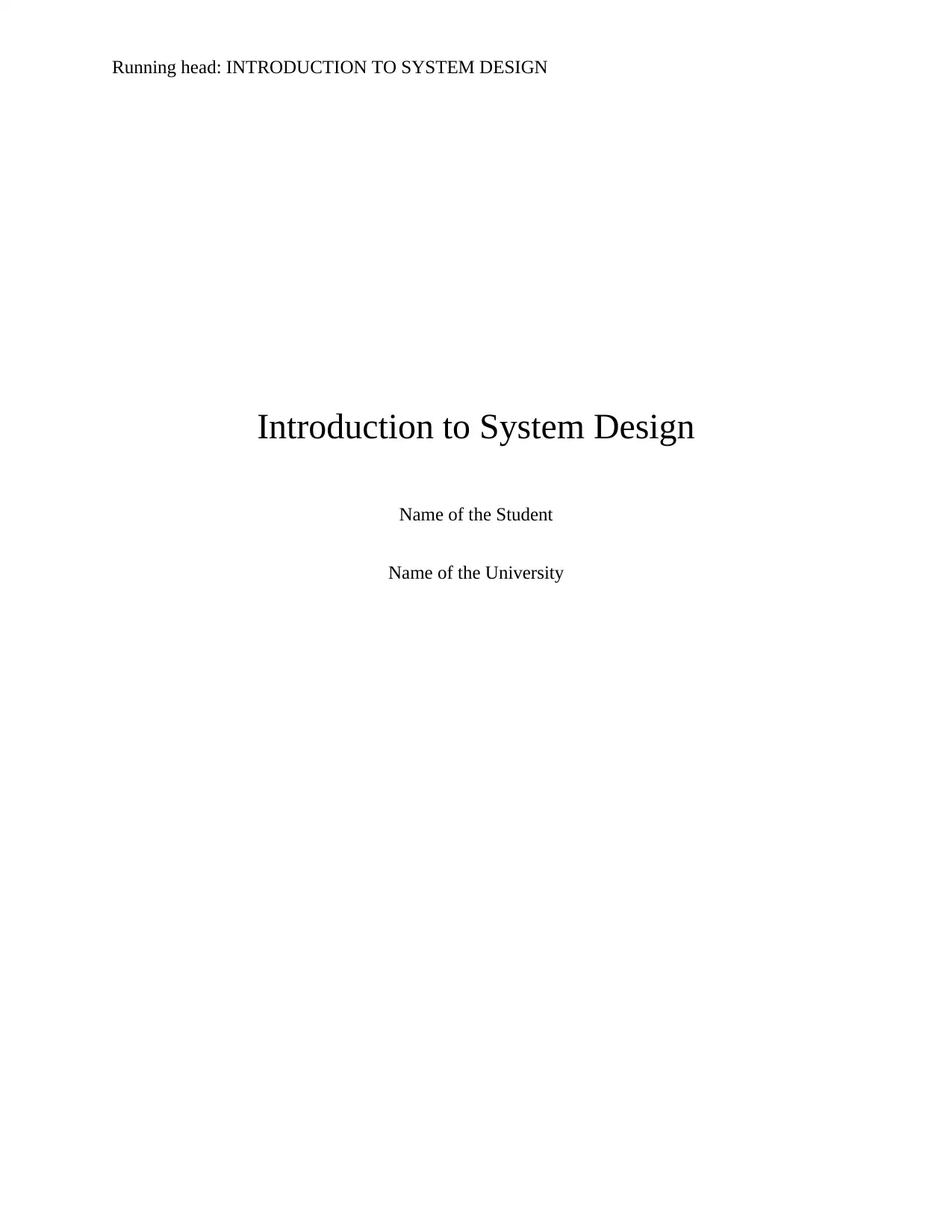
Running head: INTRODUCTION TO SYSTEM DESIGN
Introduction to System Design
Name of the Student
Name of the University
Introduction to System Design
Name of the Student
Name of the University
Paraphrase This Document
Need a fresh take? Get an instant paraphrase of this document with our AI Paraphraser
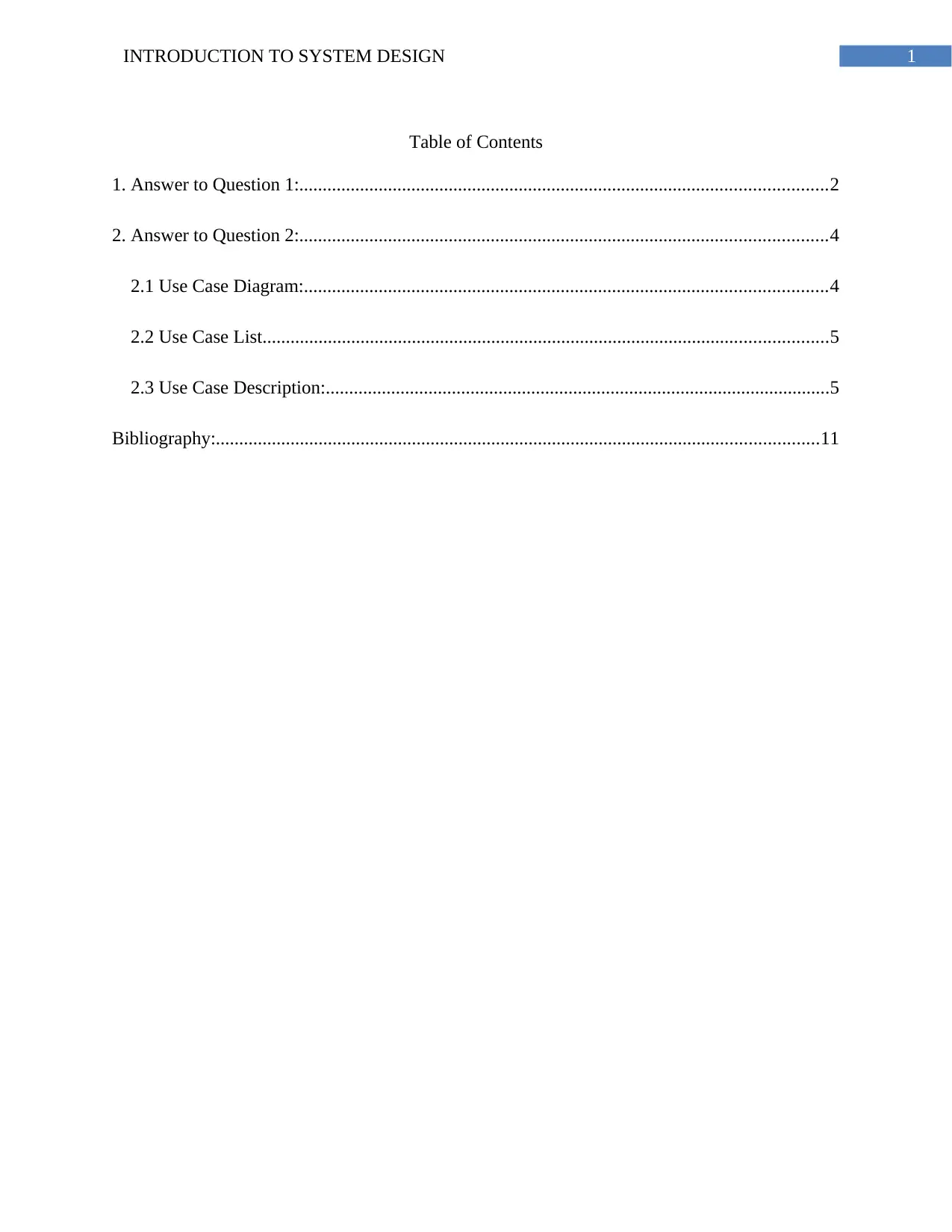
1INTRODUCTION TO SYSTEM DESIGN
Table of Contents
1. Answer to Question 1:.................................................................................................................2
2. Answer to Question 2:.................................................................................................................4
2.1 Use Case Diagram:................................................................................................................4
2.2 Use Case List.........................................................................................................................5
2.3 Use Case Description:............................................................................................................5
Bibliography:.................................................................................................................................11
Table of Contents
1. Answer to Question 1:.................................................................................................................2
2. Answer to Question 2:.................................................................................................................4
2.1 Use Case Diagram:................................................................................................................4
2.2 Use Case List.........................................................................................................................5
2.3 Use Case Description:............................................................................................................5
Bibliography:.................................................................................................................................11
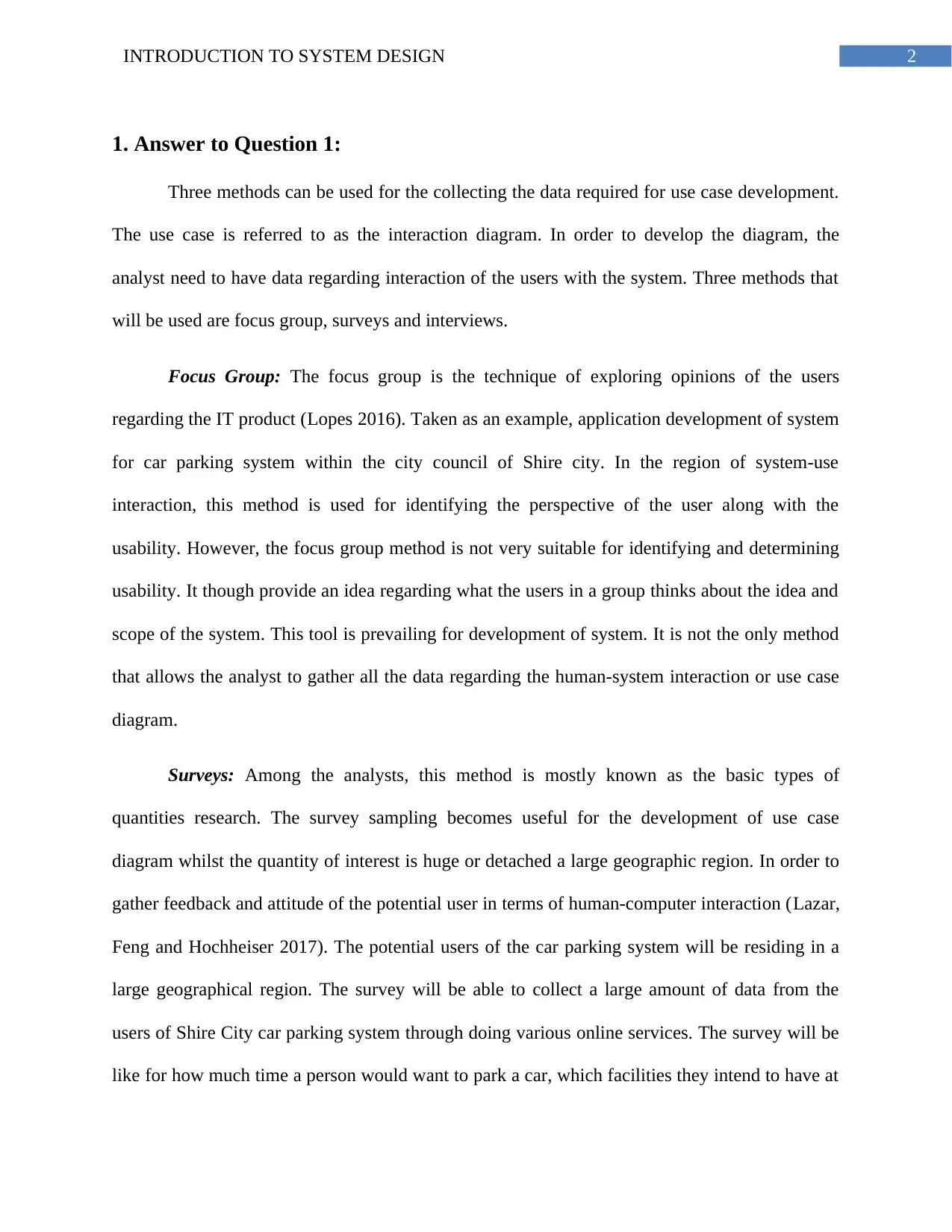
2INTRODUCTION TO SYSTEM DESIGN
1. Answer to Question 1:
Three methods can be used for the collecting the data required for use case development.
The use case is referred to as the interaction diagram. In order to develop the diagram, the
analyst need to have data regarding interaction of the users with the system. Three methods that
will be used are focus group, surveys and interviews.
Focus Group: The focus group is the technique of exploring opinions of the users
regarding the IT product (Lopes 2016). Taken as an example, application development of system
for car parking system within the city council of Shire city. In the region of system-use
interaction, this method is used for identifying the perspective of the user along with the
usability. However, the focus group method is not very suitable for identifying and determining
usability. It though provide an idea regarding what the users in a group thinks about the idea and
scope of the system. This tool is prevailing for development of system. It is not the only method
that allows the analyst to gather all the data regarding the human-system interaction or use case
diagram.
Surveys: Among the analysts, this method is mostly known as the basic types of
quantities research. The survey sampling becomes useful for the development of use case
diagram whilst the quantity of interest is huge or detached a large geographic region. In order to
gather feedback and attitude of the potential user in terms of human-computer interaction (Lazar,
Feng and Hochheiser 2017). The potential users of the car parking system will be residing in a
large geographical region. The survey will be able to collect a large amount of data from the
users of Shire City car parking system through doing various online services. The survey will be
like for how much time a person would want to park a car, which facilities they intend to have at
1. Answer to Question 1:
Three methods can be used for the collecting the data required for use case development.
The use case is referred to as the interaction diagram. In order to develop the diagram, the
analyst need to have data regarding interaction of the users with the system. Three methods that
will be used are focus group, surveys and interviews.
Focus Group: The focus group is the technique of exploring opinions of the users
regarding the IT product (Lopes 2016). Taken as an example, application development of system
for car parking system within the city council of Shire city. In the region of system-use
interaction, this method is used for identifying the perspective of the user along with the
usability. However, the focus group method is not very suitable for identifying and determining
usability. It though provide an idea regarding what the users in a group thinks about the idea and
scope of the system. This tool is prevailing for development of system. It is not the only method
that allows the analyst to gather all the data regarding the human-system interaction or use case
diagram.
Surveys: Among the analysts, this method is mostly known as the basic types of
quantities research. The survey sampling becomes useful for the development of use case
diagram whilst the quantity of interest is huge or detached a large geographic region. In order to
gather feedback and attitude of the potential user in terms of human-computer interaction (Lazar,
Feng and Hochheiser 2017). The potential users of the car parking system will be residing in a
large geographical region. The survey will be able to collect a large amount of data from the
users of Shire City car parking system through doing various online services. The survey will be
like for how much time a person would want to park a car, which facilities they intend to have at
⊘ This is a preview!⊘
Do you want full access?
Subscribe today to unlock all pages.

Trusted by 1+ million students worldwide
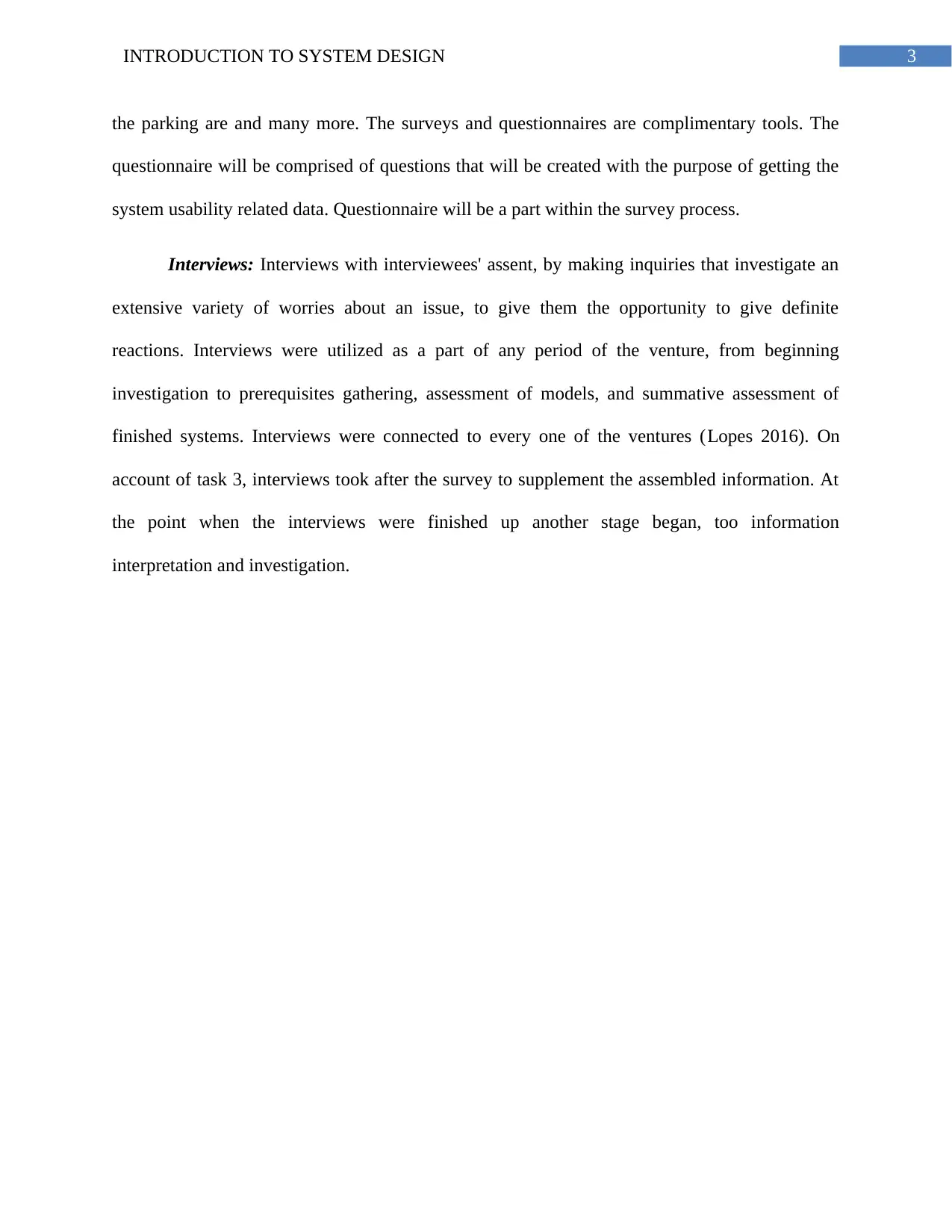
3INTRODUCTION TO SYSTEM DESIGN
the parking are and many more. The surveys and questionnaires are complimentary tools. The
questionnaire will be comprised of questions that will be created with the purpose of getting the
system usability related data. Questionnaire will be a part within the survey process.
Interviews: Interviews with interviewees' assent, by making inquiries that investigate an
extensive variety of worries about an issue, to give them the opportunity to give definite
reactions. Interviews were utilized as a part of any period of the venture, from beginning
investigation to prerequisites gathering, assessment of models, and summative assessment of
finished systems. Interviews were connected to every one of the ventures (Lopes 2016). On
account of task 3, interviews took after the survey to supplement the assembled information. At
the point when the interviews were finished up another stage began, too information
interpretation and investigation.
the parking are and many more. The surveys and questionnaires are complimentary tools. The
questionnaire will be comprised of questions that will be created with the purpose of getting the
system usability related data. Questionnaire will be a part within the survey process.
Interviews: Interviews with interviewees' assent, by making inquiries that investigate an
extensive variety of worries about an issue, to give them the opportunity to give definite
reactions. Interviews were utilized as a part of any period of the venture, from beginning
investigation to prerequisites gathering, assessment of models, and summative assessment of
finished systems. Interviews were connected to every one of the ventures (Lopes 2016). On
account of task 3, interviews took after the survey to supplement the assembled information. At
the point when the interviews were finished up another stage began, too information
interpretation and investigation.
Paraphrase This Document
Need a fresh take? Get an instant paraphrase of this document with our AI Paraphraser
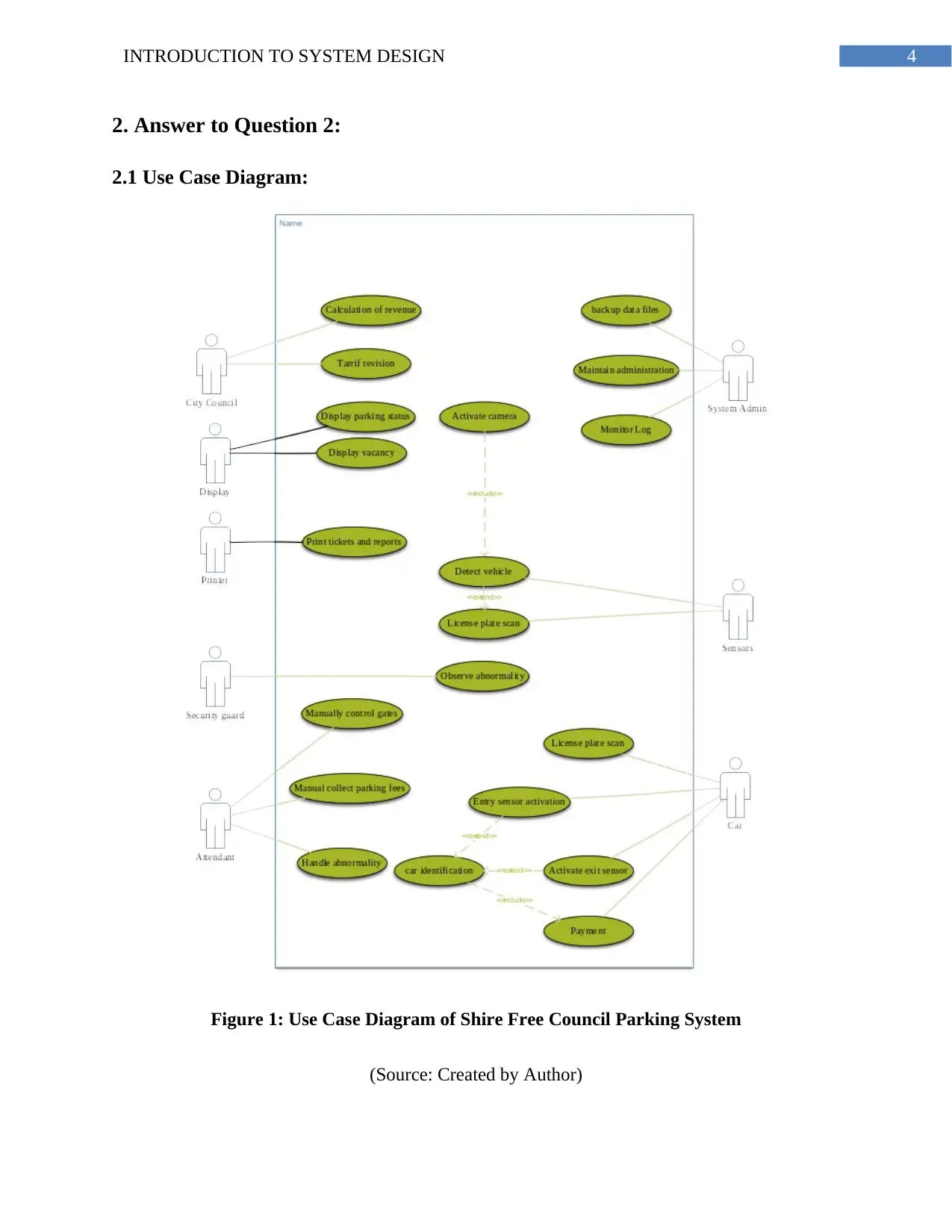
4INTRODUCTION TO SYSTEM DESIGN
2. Answer to Question 2:
2.1 Use Case Diagram:
Figure 1: Use Case Diagram of Shire Free Council Parking System
(Source: Created by Author)
2. Answer to Question 2:
2.1 Use Case Diagram:
Figure 1: Use Case Diagram of Shire Free Council Parking System
(Source: Created by Author)
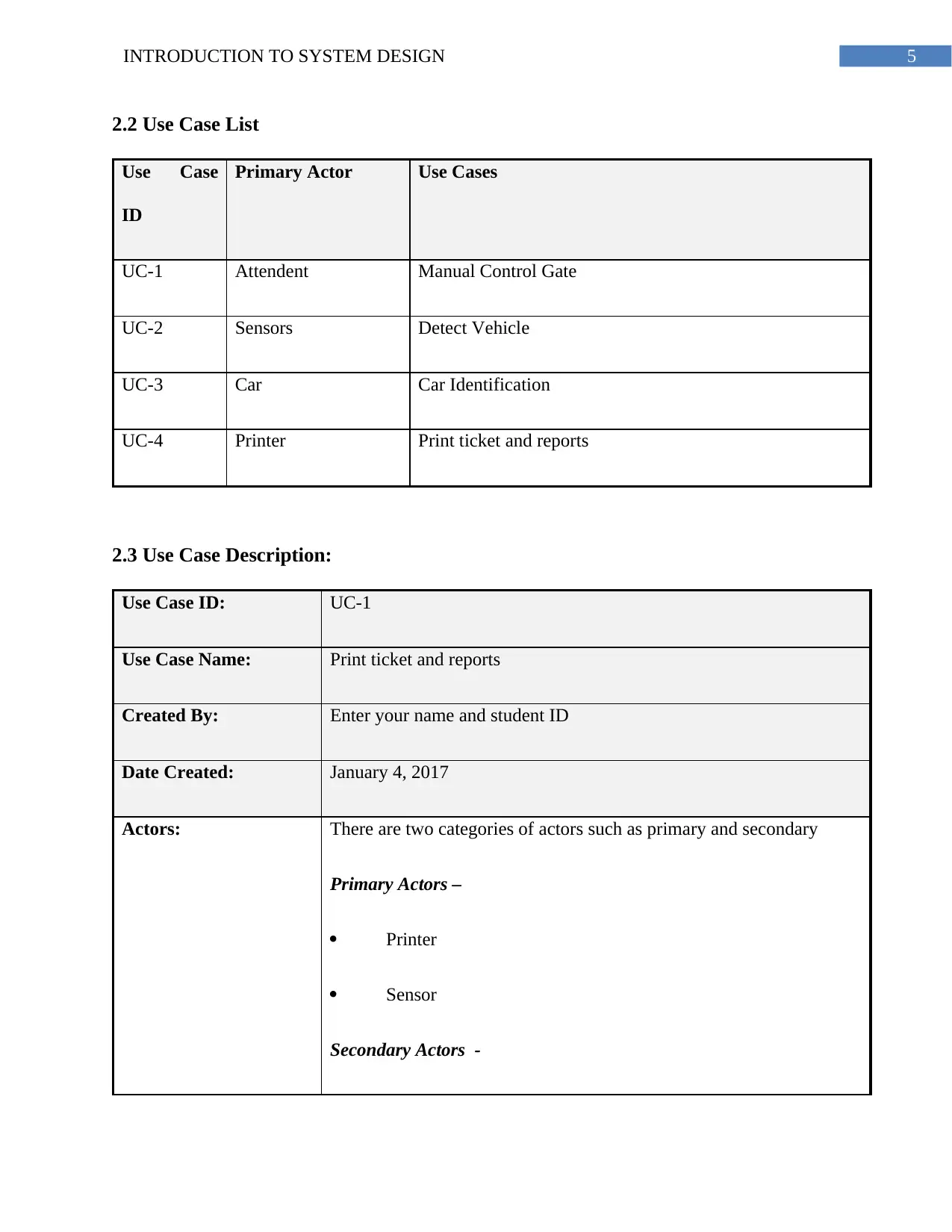
5INTRODUCTION TO SYSTEM DESIGN
2.2 Use Case List
Use Case
ID
Primary Actor Use Cases
UC-1 Attendent Manual Control Gate
UC-2 Sensors Detect Vehicle
UC-3 Car Car Identification
UC-4 Printer Print ticket and reports
2.3 Use Case Description:
Use Case ID: UC-1
Use Case Name: Print ticket and reports
Created By: Enter your name and student ID
Date Created: January 4, 2017
Actors: There are two categories of actors such as primary and secondary
Primary Actors –
Printer
Sensor
Secondary Actors -
2.2 Use Case List
Use Case
ID
Primary Actor Use Cases
UC-1 Attendent Manual Control Gate
UC-2 Sensors Detect Vehicle
UC-3 Car Car Identification
UC-4 Printer Print ticket and reports
2.3 Use Case Description:
Use Case ID: UC-1
Use Case Name: Print ticket and reports
Created By: Enter your name and student ID
Date Created: January 4, 2017
Actors: There are two categories of actors such as primary and secondary
Primary Actors –
Printer
Sensor
Secondary Actors -
⊘ This is a preview!⊘
Do you want full access?
Subscribe today to unlock all pages.

Trusted by 1+ million students worldwide
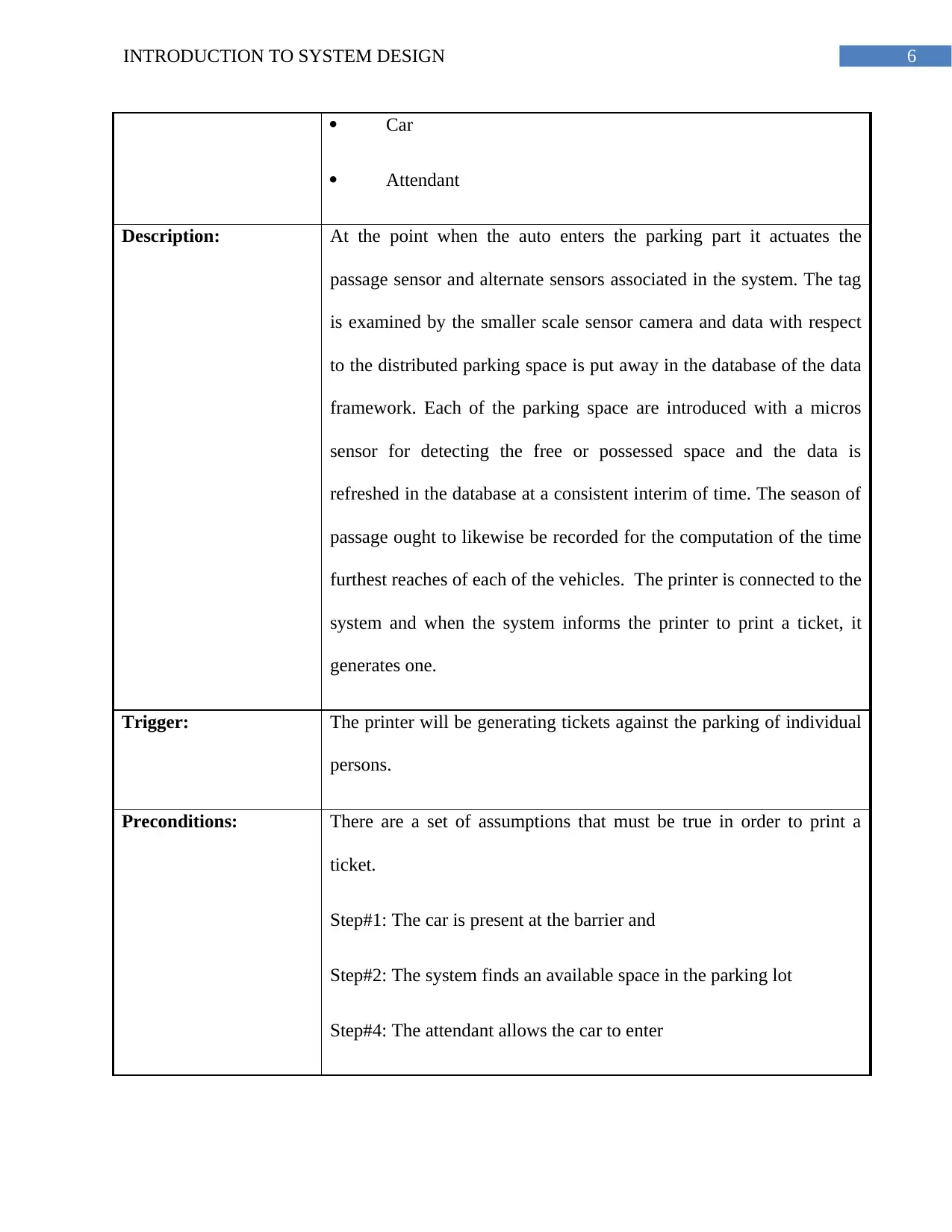
6INTRODUCTION TO SYSTEM DESIGN
Car
Attendant
Description: At the point when the auto enters the parking part it actuates the
passage sensor and alternate sensors associated in the system. The tag
is examined by the smaller scale sensor camera and data with respect
to the distributed parking space is put away in the database of the data
framework. Each of the parking space are introduced with a micros
sensor for detecting the free or possessed space and the data is
refreshed in the database at a consistent interim of time. The season of
passage ought to likewise be recorded for the computation of the time
furthest reaches of each of the vehicles. The printer is connected to the
system and when the system informs the printer to print a ticket, it
generates one.
Trigger: The printer will be generating tickets against the parking of individual
persons.
Preconditions: There are a set of assumptions that must be true in order to print a
ticket.
Step#1: The car is present at the barrier and
Step#2: The system finds an available space in the parking lot
Step#4: The attendant allows the car to enter
Car
Attendant
Description: At the point when the auto enters the parking part it actuates the
passage sensor and alternate sensors associated in the system. The tag
is examined by the smaller scale sensor camera and data with respect
to the distributed parking space is put away in the database of the data
framework. Each of the parking space are introduced with a micros
sensor for detecting the free or possessed space and the data is
refreshed in the database at a consistent interim of time. The season of
passage ought to likewise be recorded for the computation of the time
furthest reaches of each of the vehicles. The printer is connected to the
system and when the system informs the printer to print a ticket, it
generates one.
Trigger: The printer will be generating tickets against the parking of individual
persons.
Preconditions: There are a set of assumptions that must be true in order to print a
ticket.
Step#1: The car is present at the barrier and
Step#2: The system finds an available space in the parking lot
Step#4: The attendant allows the car to enter
Paraphrase This Document
Need a fresh take? Get an instant paraphrase of this document with our AI Paraphraser
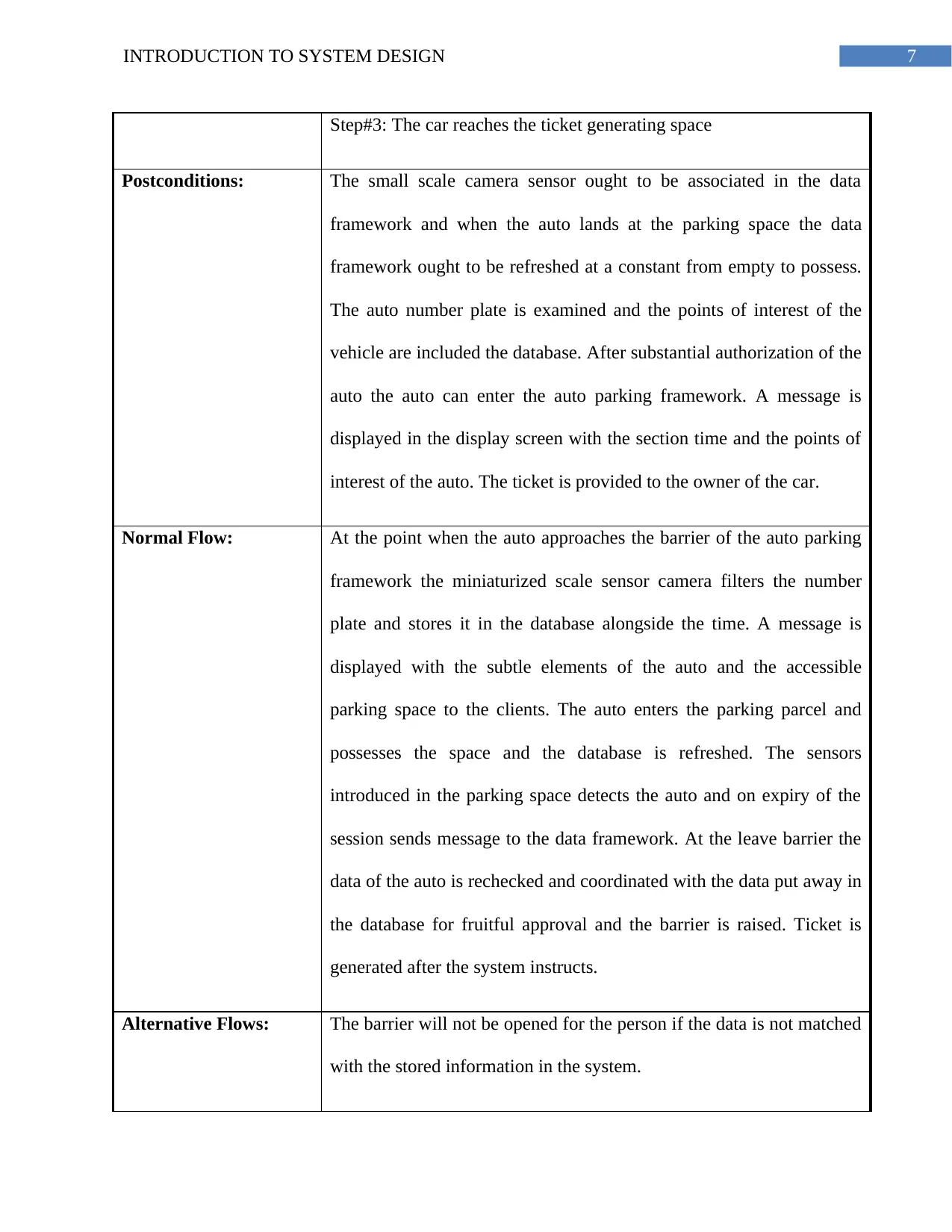
7INTRODUCTION TO SYSTEM DESIGN
Step#3: The car reaches the ticket generating space
Postconditions: The small scale camera sensor ought to be associated in the data
framework and when the auto lands at the parking space the data
framework ought to be refreshed at a constant from empty to possess.
The auto number plate is examined and the points of interest of the
vehicle are included the database. After substantial authorization of the
auto the auto can enter the auto parking framework. A message is
displayed in the display screen with the section time and the points of
interest of the auto. The ticket is provided to the owner of the car.
Normal Flow: At the point when the auto approaches the barrier of the auto parking
framework the miniaturized scale sensor camera filters the number
plate and stores it in the database alongside the time. A message is
displayed with the subtle elements of the auto and the accessible
parking space to the clients. The auto enters the parking parcel and
possesses the space and the database is refreshed. The sensors
introduced in the parking space detects the auto and on expiry of the
session sends message to the data framework. At the leave barrier the
data of the auto is rechecked and coordinated with the data put away in
the database for fruitful approval and the barrier is raised. Ticket is
generated after the system instructs.
Alternative Flows: The barrier will not be opened for the person if the data is not matched
with the stored information in the system.
Step#3: The car reaches the ticket generating space
Postconditions: The small scale camera sensor ought to be associated in the data
framework and when the auto lands at the parking space the data
framework ought to be refreshed at a constant from empty to possess.
The auto number plate is examined and the points of interest of the
vehicle are included the database. After substantial authorization of the
auto the auto can enter the auto parking framework. A message is
displayed in the display screen with the section time and the points of
interest of the auto. The ticket is provided to the owner of the car.
Normal Flow: At the point when the auto approaches the barrier of the auto parking
framework the miniaturized scale sensor camera filters the number
plate and stores it in the database alongside the time. A message is
displayed with the subtle elements of the auto and the accessible
parking space to the clients. The auto enters the parking parcel and
possesses the space and the database is refreshed. The sensors
introduced in the parking space detects the auto and on expiry of the
session sends message to the data framework. At the leave barrier the
data of the auto is rechecked and coordinated with the data put away in
the database for fruitful approval and the barrier is raised. Ticket is
generated after the system instructs.
Alternative Flows: The barrier will not be opened for the person if the data is not matched
with the stored information in the system.
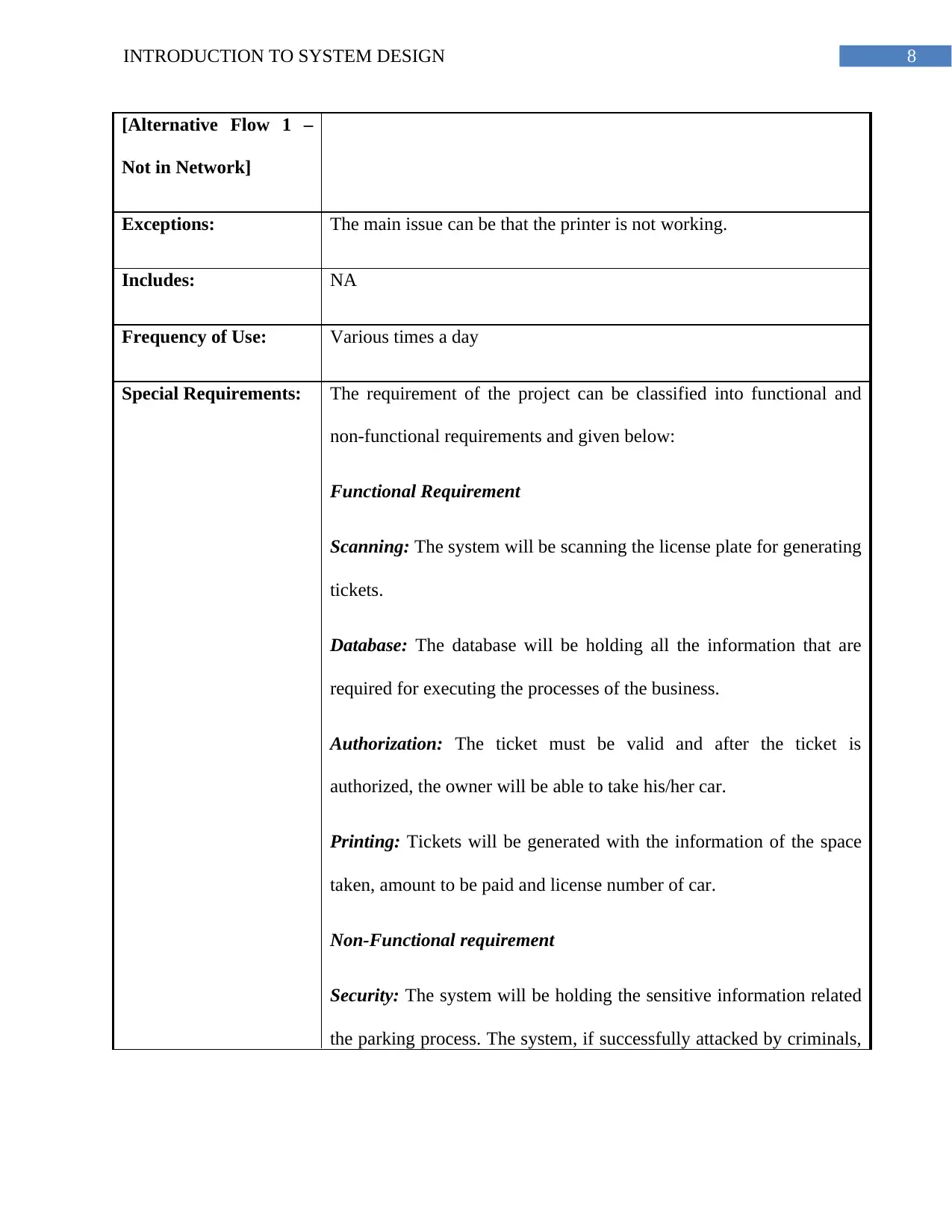
8INTRODUCTION TO SYSTEM DESIGN
[Alternative Flow 1 –
Not in Network]
Exceptions: The main issue can be that the printer is not working.
Includes: NA
Frequency of Use: Various times a day
Special Requirements: The requirement of the project can be classified into functional and
non-functional requirements and given below:
Functional Requirement
Scanning: The system will be scanning the license plate for generating
tickets.
Database: The database will be holding all the information that are
required for executing the processes of the business.
Authorization: The ticket must be valid and after the ticket is
authorized, the owner will be able to take his/her car.
Printing: Tickets will be generated with the information of the space
taken, amount to be paid and license number of car.
Non-Functional requirement
Security: The system will be holding the sensitive information related
the parking process. The system, if successfully attacked by criminals,
[Alternative Flow 1 –
Not in Network]
Exceptions: The main issue can be that the printer is not working.
Includes: NA
Frequency of Use: Various times a day
Special Requirements: The requirement of the project can be classified into functional and
non-functional requirements and given below:
Functional Requirement
Scanning: The system will be scanning the license plate for generating
tickets.
Database: The database will be holding all the information that are
required for executing the processes of the business.
Authorization: The ticket must be valid and after the ticket is
authorized, the owner will be able to take his/her car.
Printing: Tickets will be generated with the information of the space
taken, amount to be paid and license number of car.
Non-Functional requirement
Security: The system will be holding the sensitive information related
the parking process. The system, if successfully attacked by criminals,
⊘ This is a preview!⊘
Do you want full access?
Subscribe today to unlock all pages.

Trusted by 1+ million students worldwide
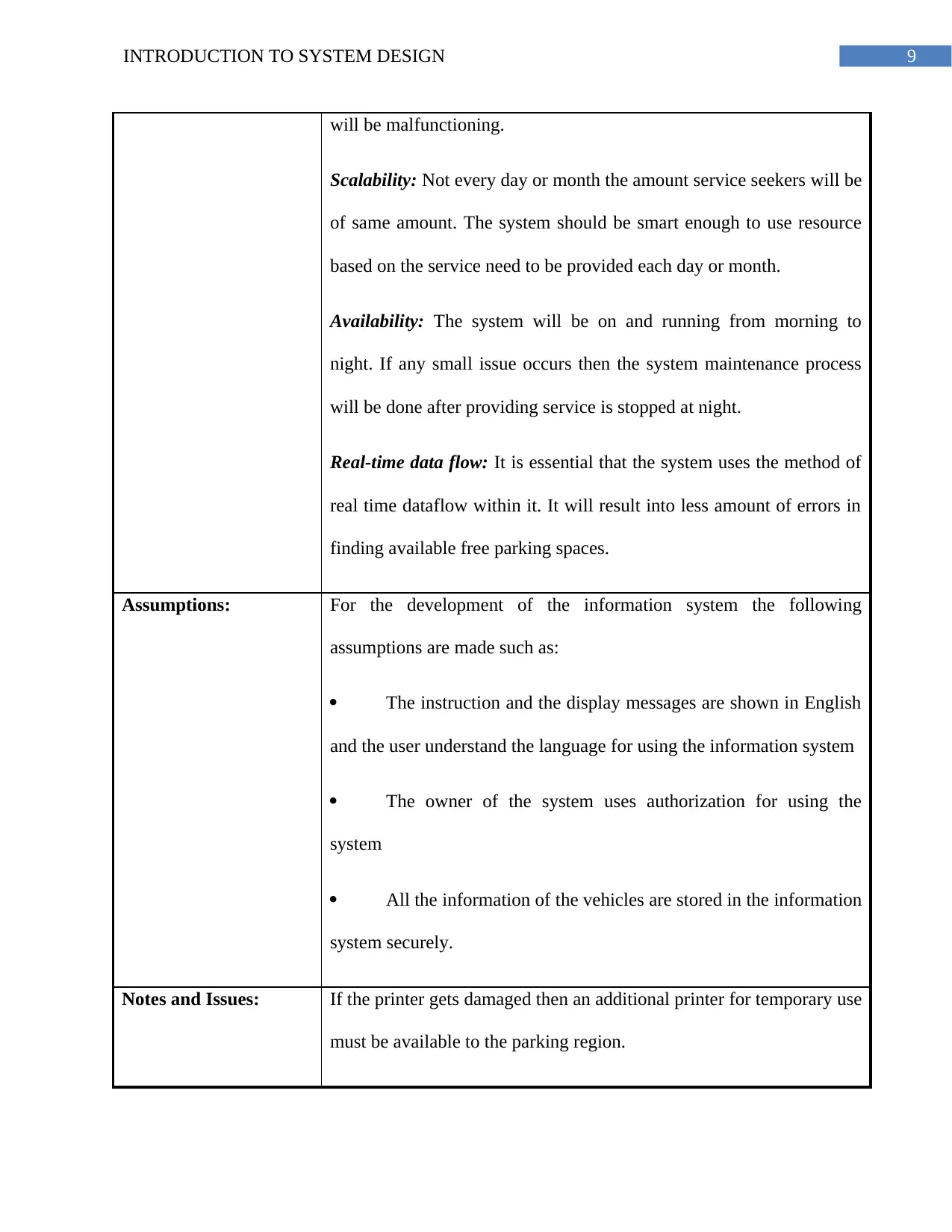
9INTRODUCTION TO SYSTEM DESIGN
will be malfunctioning.
Scalability: Not every day or month the amount service seekers will be
of same amount. The system should be smart enough to use resource
based on the service need to be provided each day or month.
Availability: The system will be on and running from morning to
night. If any small issue occurs then the system maintenance process
will be done after providing service is stopped at night.
Real-time data flow: It is essential that the system uses the method of
real time dataflow within it. It will result into less amount of errors in
finding available free parking spaces.
Assumptions: For the development of the information system the following
assumptions are made such as:
The instruction and the display messages are shown in English
and the user understand the language for using the information system
The owner of the system uses authorization for using the
system
All the information of the vehicles are stored in the information
system securely.
Notes and Issues: If the printer gets damaged then an additional printer for temporary use
must be available to the parking region.
will be malfunctioning.
Scalability: Not every day or month the amount service seekers will be
of same amount. The system should be smart enough to use resource
based on the service need to be provided each day or month.
Availability: The system will be on and running from morning to
night. If any small issue occurs then the system maintenance process
will be done after providing service is stopped at night.
Real-time data flow: It is essential that the system uses the method of
real time dataflow within it. It will result into less amount of errors in
finding available free parking spaces.
Assumptions: For the development of the information system the following
assumptions are made such as:
The instruction and the display messages are shown in English
and the user understand the language for using the information system
The owner of the system uses authorization for using the
system
All the information of the vehicles are stored in the information
system securely.
Notes and Issues: If the printer gets damaged then an additional printer for temporary use
must be available to the parking region.
Paraphrase This Document
Need a fresh take? Get an instant paraphrase of this document with our AI Paraphraser

10INTRODUCTION TO SYSTEM DESIGN
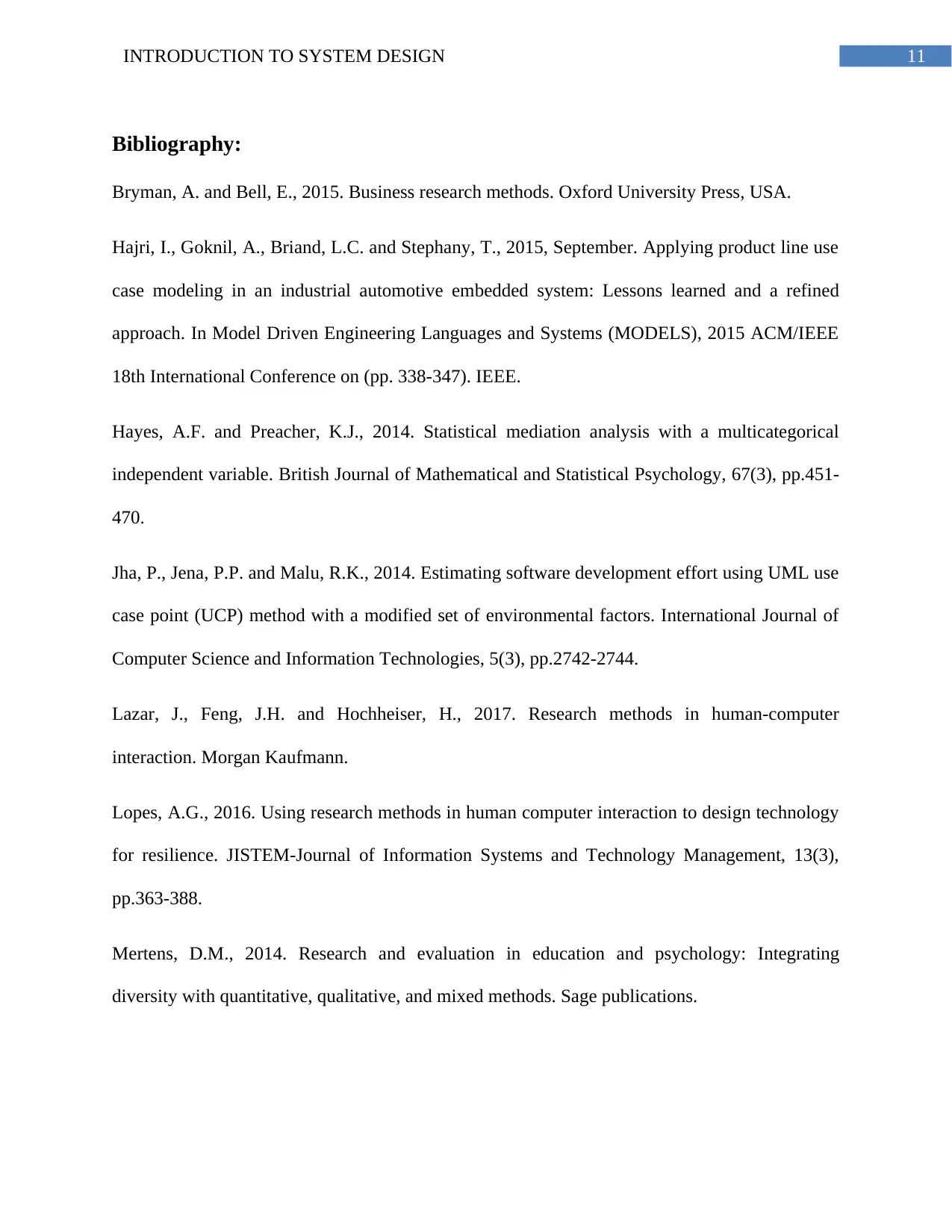
11INTRODUCTION TO SYSTEM DESIGN
Bibliography:
Bryman, A. and Bell, E., 2015. Business research methods. Oxford University Press, USA.
Hajri, I., Goknil, A., Briand, L.C. and Stephany, T., 2015, September. Applying product line use
case modeling in an industrial automotive embedded system: Lessons learned and a refined
approach. In Model Driven Engineering Languages and Systems (MODELS), 2015 ACM/IEEE
18th International Conference on (pp. 338-347). IEEE.
Hayes, A.F. and Preacher, K.J., 2014. Statistical mediation analysis with a multicategorical
independent variable. British Journal of Mathematical and Statistical Psychology, 67(3), pp.451-
470.
Jha, P., Jena, P.P. and Malu, R.K., 2014. Estimating software development effort using UML use
case point (UCP) method with a modified set of environmental factors. International Journal of
Computer Science and Information Technologies, 5(3), pp.2742-2744.
Lazar, J., Feng, J.H. and Hochheiser, H., 2017. Research methods in human-computer
interaction. Morgan Kaufmann.
Lopes, A.G., 2016. Using research methods in human computer interaction to design technology
for resilience. JISTEM-Journal of Information Systems and Technology Management, 13(3),
pp.363-388.
Mertens, D.M., 2014. Research and evaluation in education and psychology: Integrating
diversity with quantitative, qualitative, and mixed methods. Sage publications.
Bibliography:
Bryman, A. and Bell, E., 2015. Business research methods. Oxford University Press, USA.
Hajri, I., Goknil, A., Briand, L.C. and Stephany, T., 2015, September. Applying product line use
case modeling in an industrial automotive embedded system: Lessons learned and a refined
approach. In Model Driven Engineering Languages and Systems (MODELS), 2015 ACM/IEEE
18th International Conference on (pp. 338-347). IEEE.
Hayes, A.F. and Preacher, K.J., 2014. Statistical mediation analysis with a multicategorical
independent variable. British Journal of Mathematical and Statistical Psychology, 67(3), pp.451-
470.
Jha, P., Jena, P.P. and Malu, R.K., 2014. Estimating software development effort using UML use
case point (UCP) method with a modified set of environmental factors. International Journal of
Computer Science and Information Technologies, 5(3), pp.2742-2744.
Lazar, J., Feng, J.H. and Hochheiser, H., 2017. Research methods in human-computer
interaction. Morgan Kaufmann.
Lopes, A.G., 2016. Using research methods in human computer interaction to design technology
for resilience. JISTEM-Journal of Information Systems and Technology Management, 13(3),
pp.363-388.
Mertens, D.M., 2014. Research and evaluation in education and psychology: Integrating
diversity with quantitative, qualitative, and mixed methods. Sage publications.
⊘ This is a preview!⊘
Do you want full access?
Subscribe today to unlock all pages.

Trusted by 1+ million students worldwide
1 out of 12
Related Documents
Your All-in-One AI-Powered Toolkit for Academic Success.
+13062052269
info@desklib.com
Available 24*7 on WhatsApp / Email
![[object Object]](/_next/static/media/star-bottom.7253800d.svg)
Unlock your academic potential
Copyright © 2020–2025 A2Z Services. All Rights Reserved. Developed and managed by ZUCOL.




